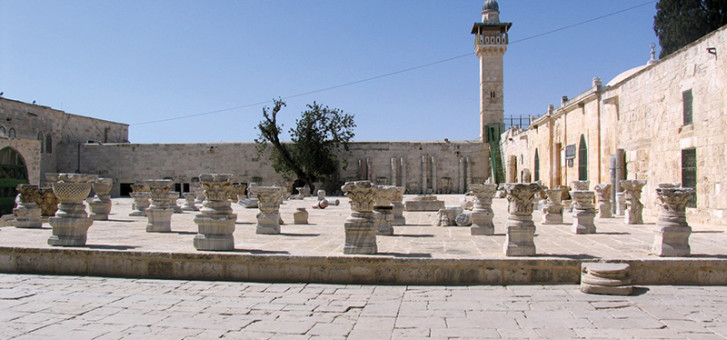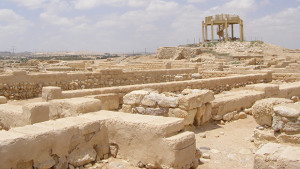Ancient Israel is to prophets what modern Kenya is to runners—or what Australia is to shark-attacks! Israel produced superstar prophets such as Jeremiah, who was told by God to wear a cattle yoke around his neck as a kind of ancient performance art, sending a visual message to the nation (Jeremiah 27:1–11). Israel also had Jonah, who delivered his message of doom while no doubt smelling somewhat fishy, which obviously had an effect, because the people of Nineveh repented (Jonah 3:6–9).
One of the greatest biblical prophets was Isaiah, who predicted that the Persian monarch Cyrus the Great would rebuild Jerusalem (Isaiah 44:24–28). This was a particularly impressive prophecy, because God called Cyrus by name more than a century before the king-to-be was even born!
Cyrus, a general in the army of the Medes, must have felt bad that the Jews no longer had a temple. Solomon had constructed the original temple over a period of seven years, and by all accounts it was a wonder. Then the Babylonians invaded and burned it to the ground. Cyrus gave orders to rebuild the edifice, and he returned all the temple valuables that had been looted by the Babylonians.
This second temple lasted until AD 70, when it was razed to the ground by Roman soldiers under Titus. Today, many orthodox Jews long to re-establish the temple and its ancient systems, including the sacrifices. Some even hope that the story of Cyrus will be repeated by a modern ruler.
These Jews took great encouragement when Donald Trump won the 2016 presidential election in the United States because they remembered his promise to recognise Jerusalem as Israel’s capital. They also note that Russian leader Vladimir Putin has expressed a desire for the temple to be restored. “We are poised to rebuild the Temple,” said Rabbi Hillel Weiss, spokesman for a group called the Nascent Sanhedrin. “The political conditions today, in which the two most important national leaders in the world support the Jewish right to Jerusalem as their spiritual inheritance, is historically unprecedented.”
The hope that orthodox Jews have placed in the leaders of the world’s two most powerful Christian nations may or may not be well placed. But they’ve been quietly advancing toward their goal of rebuilding the temple for decades. They’ve even bred the flawless red heifers that were specified for the temple sacrifices (Numbers 19:1–8). They’ve also sought out descendants of the tribe of Levi who would be qualified to conduct temple services. But the requirements for ritual purity are pretty stringent for such recruits. Potential priests can never come into proximity with the dead, so they must never have been in a hospital or have entered a cemetery at any time in their lives. Ever. They aren’t even allowed to have been in a hospital at the occasion of their own birth!
Perhaps the most expensive preparation for the new temple has been a re-creation of the seven-branched candlestick, also called a menorah. A goldsmith used one talent (about 45 kilos) of 24-carat gold to make the massive candelabra to the same biblical specifications as the one that was made for Solomon’s temple.
These preparations are of interest to many outside of the Jewish faith as well. Some Christians see the erection of a temple as setting the stage for end-time events. “The Bible clearly teaches that a new temple—which will be called The Third Temple—will be built in the future,” says David R Reagan of Lamb & Lion Ministries.
Isaiah, one of the most important of the Bible’s Old Testament prophets, had this to say: “In the last days the mountain of the Lord’s temple will be established as the highest of the mountains. . . .
“Many peoples will come and say, ‘Come, let us go up to the mountain of the LORD, To the temple of the God of Jacob’ ” (Isaiah 2:2, 3).
Amos, an Old Testament prophet, said: “In that day I will restore David’s fallen shelter—I will repair its broken walls and restore its ruins—and will rebuild it as it used to be” (Amos 9:11).
In 1948, we saw the establishment of Israel as a nation. Do these prophecies promise that we will see the restoration of the temple? Will the smoke of ritual sacrifices rise once again in Jerusalem after almost 2000 years?
The simple answer is “yes.” But here’s a surprising twist: this new temple has already been built! Do I detect some scepticism? Are you thinking that someone would surely have noticed if a temple had gone up in Jerusalem’s biggest tourist spot? Well, let me explain with a text from Ephesians 2: “Consequently, you are no longer foreigners and strangers, but fellow citizens with God’s people and also members of his household, built on the foundation of the apostles and prophets, with Christ Jesus himself as the chief cornerstone. In him the whole building is joined together and rises to become a holy temple in the Lord. And in him you too are being built together to become a dwelling in which God lives by his Spirit” (verses 19–22).
After the Jews rejected Jesus, He built a new kind of “temple,” and He made it, not with stones, bricks and mortar, but with people—a “living” temple. He promised to live in these people in the same way that His glory filled the temple in ancient times.
"Will the smoke of ritual sacrifices rise once again in Jerusalem?"
Yes, it sounds a little strange, but it was a concept fully grasped by the first-century believers. Remember the prophecy about rebuilding the temple that we mentioned from the book of Amos a few minutes ago? That same prophecy is quoted by the apostle Peter in the New Testament in referring to members of the church (1 Peter 2:4, 5). As he understood it, Jesus has taken His temple to a whole new level. It’s no longer confined to one spot in a geopolitical world. It’s now embodied in every living, breathing Christian.
So will there likely be a Jewish temple constructed anyway? Maybe. Maybe not. But if it is built, it will have no more prophetic meaning than yet another new Starbucks going up in Auckland. It will be just another building.
If you want to see God’s newest dwelling place, you won’t have to go far. Look for a person full of the love of Jesus. That’s God’s new temple. And, like Solomon’s temple, that kind of person is a wonder to behold.






